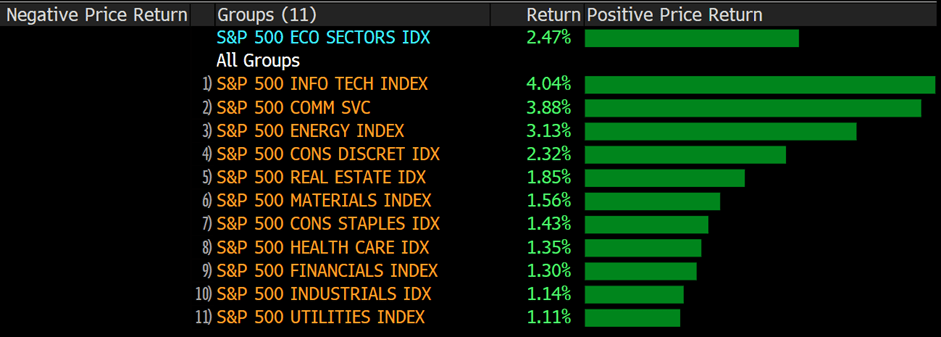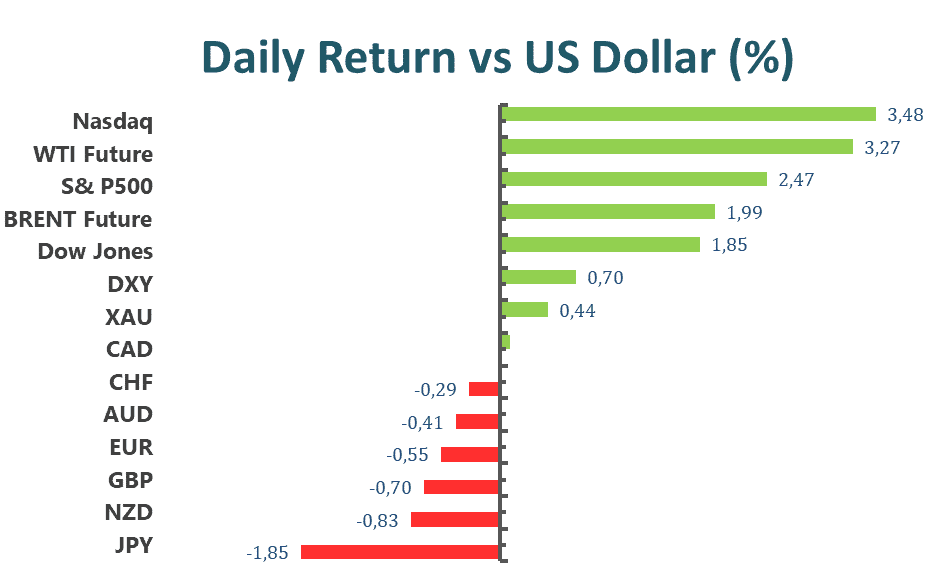U.S. equities closed sharply higher Thursday, led by technology shares as markets continued recovery from steep losses earlier this week. S&P 500 climbed 2.5%, and Dow Jones surged by more than 600 points or 1.8%. The tech-heavy Nasdaq Composite jumped 3.1% to cap trading, marking its best rise since March on the heels of stronger-than-expected earnings from Facebook parent company Meta (FB) that boosted shares up nearly 18%.

Apple Inc. predicted that supply constraints would cost $4 billion to $8 billion in revenue during the current quarter, a warning that sent the shares tumbling and cast a pall on record-setting results that the company just reported.
Covid restrictions, which have swept China in recent weeks, will take a toll on the June quarter, Apple said during a conference call Thursday. The fiscal second quarter’s sales and profit had topped analysts’ estimates, fueled by strong demand for the iPhone and digital services, and the company announced $90 billion in new stock buybacks.
The outlook renewed fears that supply-chain woes will continue to roil the tech industry following a short-lived recovery from pandemic struggles. Companies ranging from Microsoft Corp. to Texas Instruments Inc. have already said that China’s Covid-19 lockdowns will crimp sales and make it harder to produce products like the Xbox. The Xi Jinping administration has embraced a strict Zero Covid policy to stop the pandemic’s spread, reverberating through the world’s supply lines.
Chip shortages and the Ukraine war also are causing disruptions, Chief Executive Officer Tim Cook said during the call. “We are not immune to these challenges, but we have great confidence in our teams, and our products and services — and in our strategy.”

Main Pairs Movement
Despite a shocking decline in the latest GDP release, the greenback advanced across the board on Thursday. The Dollar Index surpassed its 2017 highs to almost hit 104.00, its highest level since December 2002. This was primarily a result of a steep sell-off in the yen that launched USD/JPY to fresh multi-decade highs of at one point above 131.00.
The catalyst for the latest leg lower in the yen, which saw all major G10/JPY pairs surge, not just USD/JPY, was Thursday’s dovish BoJ policy announcement. As expected, the bank doubled down on its intent to stick with its ultra-dovish policies of negative interest rates and yield curve control for the foreseeable future given continued pessimism about its ability to meet its long-term inflation remit.
Elsewhere, most other major G10 currencies also continued to depreciate versus the rampant US dollar. The Euro pair dropped a further 0.5% and briefly dipped under 1.0500 for the first time since March 2017, GBP/USD dropped a further 0.6% to the mid-1.2400s and AUD/USD fell another 0.4% to probe 0.7100. NZD/USD dropped another 0.8% to fresh lows in July 2020 under 0.6500. Expectations for the BoE and RBA to both lift interest rates by 25 and 15 bps each next week have done little to stem the recent slide as both of these hikes pale in comparison to the 50 bps move expected from the Fed not only next week’s meeting but also the next few.
Technical Analysis
USDJPY (4-Hour Chart)

USDJPY hits 131.00 for the first time in two decades as the Fed- BOJ monetary policy divergence widens. On Thursday, the Bank of Japan continues to keep the key rates unchanged though it doubles down on bond buying. From the technical perspective, USDJPY stays in a strong bid tone on the four-hour chart following the breakout of the resistance level of 128.98. Failure to defend the cap level results in attracting more buying interests. At the time of writing, USDJPY is attempting to break the next obstacle, 131.24, in two decades; however, as the RSI indicator has reached near the 80 mark, the upside momentum might need to cool down a bit before continuing to head upward. To the downside, USDJPY needs to slide below 127.58 in order to become downside.
Resistance: 131.24
Support: 128.98, 127.58, 126.45
XAUUSD (4-Hour Chart)

The bright metal fails to recover, consolidating around $1885, though US GDP figures shock with a contraction. However, weak US economic data seem to unlikely change that fact the Fed is going to hike interest rates by 50 bps in May and remains in an aggressive stance later this year. Technically speaking, gold faces a barricade at nearly $1990. In order to gain some follow-through buying, gold needs to climb above $1990, where the midline of Bollinger Band, suggests a reverse from bearish to bullish in the near- term. At the time of writing, bulls seem to lack interest as the RSI still hovers within the negative level, implying that sellers are still in control.
Resistance: 1890, 1916, 1940, 1950
Support: 1878, 1877, 1828
USDCAD (4-Hour Chart)

USDCAD eases from multi-week high amid dismal US economic data, showing a contraction in US GDP print. Technically speaking, though USDCAD loses traction after hitting near the 1.2900 level, the downside seems limited. At the time of writing, USDCAD heads south toward the support of 1.27. If the level can defend the bearish momentum, then according to the Elliott Wave point of view, it is expected to see one more upside wave. As the RSI indicator eases from the overbought territory, USDCAD looks to rebound once it hits the support of 1.27. Nonetheless, if the support of 1.27 fails to defend, then it will favor the sellers, attracting some follow-through selling interests.
Resistance: 1.2900
Support: 1.2793, 1.2694, 1.2542
Economic Data
| Currency | Data | Time (GMT + 8) | Forecast |
| CNY | Caixin Manufacturing PMI(Apr) | 09:45 | 50 |
| EUR | German GDP(QoQ)(Q1) | 16:00 | 0.1% |
| EUR | CPI(YoY)(Apr) | 17:00 | 7.5% |
| RUB | Interest Rate Decision (Apr) | 18:30 | 15% |
| CAD | GDP(MoM)(Apr) | 20:30 | 0.8% |